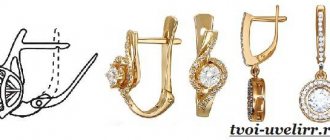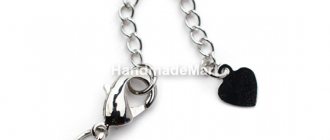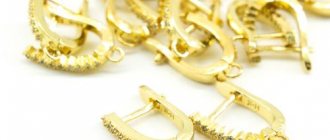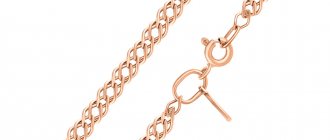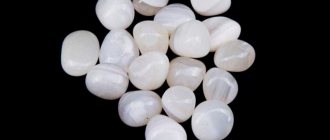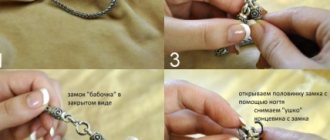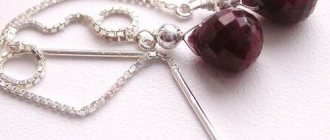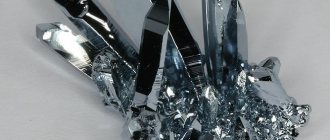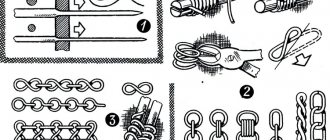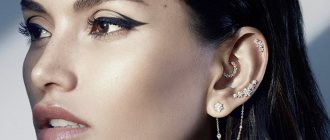See all studs with a screw lock in the Sunlight catalog
Advantages:
- Reliable fastening. Protection against loss of earrings.
- The length of the nail can be adjusted to suit different thicknesses of the lobe.
- Comfort.
- Versatility. The screw lock is considered the ideal clasp for everyday jewelry.
Flaws:
- Difficult to tighten the lock.
English castle
An English lock is a pin that is inserted into a puncture on the earlobe and has a hook at the end. The response part is a movable bow with a hole. The clasp closes with a characteristic click. To open an English lock, you need to slightly lift the pin with your thumb, and push the shackle back with your index finger.
Earrings with English lock
The lock is considered one of the most reliable; it is almost impossible to accidentally unfasten a working clasp. The configuration of the earring allows you to make it not only open, but also to hide it behind the base of the earring. Most often it has the shape of a rounded rectangle, but more rounded modifications are also found. All our earrings with English lock are here
What to pay attention to
- Pin length. It is important that it matches the thickness of the lobe. If the ear is thicker, the clasp will not fasten; if it is noticeably thinner, the balance of the earring will change and it will constantly fall off. In the first situation, you will have to abandon the jewelry, but in the second, you can make an additional undercut on the pin in a jewelry workshop, thereby adjusting the depth of the clasp.
- The depth of the shvenza, its internal space. In the case of a high piercing or a large earlobe, the clasp may crush the ear, which is inconvenient and unsightly.
Italian castle (omega)
The clasp resembles a clip in appearance. A straight pin is inserted into the puncture; it does not snap into place at the back, but is pressed by a movable bow with a wide loop-clip. Such a lock is reliable, but at the same time quite difficult to manufacture, therefore it is used in products made of precious metals and premium jewelry.
Earrings with Italian lock
Most often, Italian locks have medium and large earrings, the decorative part of which covers the pierced area. This design allows you to hide possible earlobe defects. However, there are also relatively small decorations and pendants on an elegant open base. Thanks to the balance of the product and the large support area (the loop-clip distributes the weight of the jewelry over the entire earlobe), even massive earrings with an Italian lock are very comfortable to wear, and the thin, smooth pin does not injure the puncture.
Unlike the English one, the similar Italian lock can be adjusted in depth. It is difficult to unfasten it unnoticed or accidentally. Keep in mind: it is necessary to monitor the serviceability of the hinge connection of the movable bow and the base of the jewelry, and if it becomes loose, take it to a jewelry workshop for tightening. All our earrings with Italian lock are here
What are the design elements of an earring?
There are two mandatory parts in the structure of an earring:
- base – outer, visible surface. It can be in the form of a simple geometric figure or a carved pattern;
- lock - a mechanism that secures jewelry.
The basis is often supplemented:
- pendant - a freely falling decorative element;
- insert - stone, crystal, bead. There may be one or several. It is held in place by a caste (frame) and a welt (rim) to the base or pendant.
The lock requires the presence of various fasteners:
- ear wires;
- hooks;
- loops;
- springs;
- staples;
- hinges;
- screws;
- clamps;
- latches
The combination of these elements gives different types of locks:
- with swinging hook;
- with spring latch;
- wire;
- screw.
There are also non-standard connections.
French castle
Locks of this type were extremely common in Soviet times. They are usually found on earrings with one accent stone or other static decorative element. It is an elastic loop that is threaded into the ear and secured with a triangular movable loop or a fixed hook, often behind the base of the jewelry.
Earrings with French lock
It is believed that earrings with a French lock are suitable for children due to their simplicity, reliability and non-traumatic nature.
Despite its apparent simplicity, it is difficult to accidentally unfasten the clasp, but even if this happens (for example, the fastening of the loop has become loose and therefore slips), the jewelry still remains in the ear.
What to pay attention to
Earrings with such a lock leave the puncture area open. This may be important if the hole in the earlobe is quite large.
Types of clasps for earrings
There are several types of earring clasps.
English castle on earrings
In earrings with an English lock, the pin of the product is threaded into the hole of the earlobe and snaps into place with a hook. A common option for classic earring styles. Advantages: secure fastening, comfortable wearing, convenient lock does not come into contact with the area around the ear.
The disadvantages of the English clasp on earrings include the inability to adjust the space between the clasp and the earlobe; also, with a wide pin, you can slightly stretch the hole in the earlobe.
Stud clasp
Suitable for everyday use and for special occasions. There are two types of stud fasteners.
The first one is in the form of a clamp that is attached to the ear through a pin threaded through the hole. This type of lock is used in jewelry for the lobe and earlobe. The advantages of stud earrings include comfortable wearing and fastening does not require effort. The disadvantages include the low reliability of the fastener. The stud may become loose with frequent use and fall off the earring.
The second type is a screw nail. Advantages: high-quality fastening of the stud, no contact with the area around the ear. Disadvantages - inconvenience in putting the nail on the pin. It is necessary to hold it as level as possible in order to screw the fastener.
French castle
It is a loop that follows the shape of the earlobe, as well as a small loop at the bottom of the earring. The loop is threaded through the ear hole and secured with a small loop. The popular French lock is very often used for business and casual jewelry, as well as for children's earrings. Advantages: no discomfort, elegant appearance of the product. Disadvantages: the loop is fragile and can be damaged by strong pressure.
Italian castle
It snaps on like a clip. The earring pin is threaded into the ear and secured with a large loop that goes around the earlobe. Used for classic, formal and everyday types of jewelry. Advantages - a convenient clasp goes almost unnoticed, comfort when wearing. Disadvantages - earrings with a fragile Italian lock must be removed at night.
Shackle lock
A movable earring is threaded through the earlobe and attached to the earring using a special ball. This is a less popular lock, more often used in oriental, gypsy large decorations. Advantages: no discomfort when wearing. Disadvantages: delicate handling is required to avoid deforming the clasp.
Earrings with loop clasp
The fastening of such an earring on the ear looks like an elongated loop without the actual clasp. For such earrings, you can purchase a silicone plug separately. A loop lock is used most often for earrings with pendants. Advantages: ease of putting on and taking off, elegant appearance. Disadvantages - a high probability of loss of the product and deformation of the thin loop.
Lock-pin for earrings
A popular type of clasp for many everyday and formal decorations. It has a short earring that is threaded into a small ring. Most often used for hoop earrings. Advantages: simple, inconspicuous fastening mechanism. The disadvantages relate more to the type of earrings - massive round jewelry cannot be touched when worn, so as not to damage the earlobe, and, moreover, with such a lock, earrings are easy to lose - they can unnoticed fly off after you touch them with a scarf.
Lock for hoop earrings (sliding, “congo”)
Also, for round earrings (a classic of the genre for this clasp is congo earrings), a clasp with a short straight earring is used, which is threaded into the opposite end of the earring. The advantages of such a lock are that it is not visible when worn, it is hidden in the earring. Disadvantages: jewelry must be removed at night to avoid damaging the earlobes.
Other types of earring locks
Jewelers, like any creative people, do not like to be limited to a set set of options for locks for earrings. Therefore, you have a good chance of purchasing earrings with a clasp that is either completely absent from the list or is an unusual variation of one of the standard types. Below are just a couple of examples of such unusual locks:
Where to buy earrings
JEWELIRUMA catalog - an updated selection of interesting jewelry brands with search filters | Where to buy designer jewelry - review of sites | Seven brands of premium jewelry presented in Russia | The main exhibitions and sales of jewelry and designer costume jewelry
TYPES OF JEWELRY | JEWELRY EARRINGS
What types of earrings are there? | How to choose earrings? | Fashion earrings | Unusual earrings. Earring on ear cartilage | Earring in a man's ear | Long earrings | Round earrings
Share this article with your friends
Works by designers from the JEWELIRUM catalog
- Co.Cos Jewelry
- Co.Cos Jewelry
- Taiga Jewelry, Tomsk
- Taiga Jewelry, Tomsk
- Ilya Maksimov, Crimea
- Ilya Maksimov, Crimea
- UBIRING
- UBIRING
- Diamonds are Forever
- Diamonds are Forever
- Rings in natural style, Sergacheva Jewelery
- Earrings with pearls, Sergacheva Jewelery
- Cabochon ring, Minty Sky
- Fly earrings, Minty Sky
- Ring, Precious Park
- Ring, Precious Park
- Snake skin ring, Stoyanova Jewelery
- Chain earrings, Stoyanova Jewelery
- Children's pendant - stick, Matthew&Daniel
- Pendant for a child, Matthew&Daniel
- Bracelet, Svetlana Subbotina
- Ring with Slavic symbols, Svetlana Subbotina
- Indian style ring, Anna Goffman
- Indian style ring, Anna Goffman
- Earrings, ISTA
- Geometric ring, ISTA
- Earrings with enamel, PNJewelry
- Ring with enamel, PNJewelry
- Ring, Khramtsova Jewelry
- Ring, Khramtsova Jewelry
- Wedding rings to order, obruchalki.com
- Wedding rings to order, obruchalki.com
- Earrings, Yuri Bylkov
- Earrings, Yuri Bylkov
- Titanium bracelets, LanaMuransky
- Titanium pendant, LanaMuransky
- Brooch Elephant (after Salvador Dali), THING
- Ring Veil, THING
- Mace earrings, VLADIMIR MARKIN
- Cufflinks, jewelry mechanics, VLADIMIR MARKIN
- Drop-shaped ring, EKATERINA TOLSTAYA
- Drop-shaped earrings, EKATERINA TOLSTAYA
- Necklace with amber, LETA
- Earrings with amber, LETA
- Children's earrings, combinable, FASHBY
- Children's earrings, combinable, FASHBY
- Ring of architectural form, Elizaveta Malafeevskaya MANU_L
- Architectural bracelet, Elizaveta Malafeevskaya MANU_L
- Set Ginkgo Leaf, SHABUT JEWELLERY
- Brooch Wearable porcelain, SHABUT JEWELLERY
- Architectural ring, GEOMETRY
- Brooch, porcelain, GEOMETRY
- Necklace made of polymer clay, LICORNE ART
- Brooch made of polymer clay, LICORNE ART
- Ring, avant-garde, VALERY SEREDIN
- Bracelet, avant-garde. VALERY SEREDIN
- Wooden set, Scandinavian/Japanese minimalism, VLADIMIR SHESTAKOV
- Ring, Scandinavian/Japanese minimalism, VLADIMIR SHESTAKOV
- Earrings, TON ANT
- Ring, TON ANT
- Architectural ring, ANCHOR
- Architectural necklace, ANCHOR
- Earrings, GOHFELD JEWELLERY
- Necklace, GOHFELD JEWELLERY
- Massive ring, YAKISCHIK
- Designer jewelry, YAKISCHIK
- Architectural ring, ONE DAY ART
- Architectural ring, ONE DAY ART
- Brooch, bionics, VALERIYA MARKOVA (TESSA)
- Unclosed ring, bionics, VALERIYA MARKOVA (TESSA)
- Ring, bionics, BEAVERS
- Earrings, bionics, BEAVERS
- Earrings, asymmetry, VAGANOVA JEWELRY
- Airplane ring, VAGANOVA JEWELRY
- Flower ring, ALCHEMIA JEWELLERY
- Set, ALCHEMIA JEWELLERY
- Pendant-cat, ethnic, STUDIO OF ILYA AND VERA PALKIN
- Earrings, STUDIO OF ILYA AND VERA PALKIN
Comments
- Natalia
Very interesting and useful information. Thank you)
5 years ago Reply
- juvelirum
Natalya, thank you!)
5 years ago Reply
Leverbeck
A kind of combo of English and French castles, and therefore combines their advantages, smoothing out the disadvantages. A thin, curved half-loop pin is inserted into the ear; behind the earlobe, it fits into the groove of the movable bow. Since the pin is longer than that of an English lock, this fastening is less demanding on the thickness of the earlobe; you only need to pay attention to whether your eyelet has enough space inside the fastener.
Leverback earrings
All our earrings with direct and reverse leverback locks are here
Cuff
See all cuff earrings in the Sunlight catalog
Advantages of the cuff:
- Modern design.
- A comfortable mount that does not put pressure on the ear, since the weight of the product is not concentrated on the earlobe, but is distributed over the entire ear.
Flaws:
- An unusual mount takes time to get used to the decoration.
Reverse lock, brizur (brizura), chohu
Nowadays it is rare, but in the 19th century it was very common among Russian jewelers. An earring with this fastening is worn at the back and snaps in front of the earlobe. The movable bow passes through the puncture in the ear and is fixed in a fixed loop or groove at the base of the jewelry. It can be similar to a French lock (a thin or tapered bow - a half-loop fits into a loop), or a leverback (a movable bow fits into a groove located on the base or on the stationary part of the clasp located in front of the lobe). This type of lock is very reliable: it is almost impossible to accidentally unfasten it. However, you will have to practice putting on the jewelry.
Earrings with reverse lock
How to wear climber earrings
Before choosing an outfit for a new decoration, it is worth remembering that this model is suitable for a classic, romantic or festive style. In everyday or office style, this model will be a little out of place. So, what options can be combined with climbers:
- a little black dress that every fashionista has in her wardrobe;
- a loose sundress or a bright wrap dress;
- evening dresses with sequins, cutouts, floor length;
- other jewelry (rings, pendants, hairpins), if they match the metal, color and decor of the earrings;
- haircuts with open ears, as well as braided hairstyles for long hair (braids, voluminous buns, etc.)
You can also wear the jewelry on only one ear. This model does not imply wearing on two earlobes at once.
Stud or carnation
One of the most popular types of locks. Its simple and at the same time reliable configuration allows this type of clasp to be used on both small studs and large chandelier earrings. It formed the basis for relatively new types of earrings: jackets and cuffs. A straight pin is inserted into the earlobe and secured with a stopper on the reverse side.
There are two types of studs: pin and screw. In the first case, the pin has a small notch into which a stopper in the shape of a lamb or cylinder with a seal inside snaps into place. This is the simplest, and therefore inexpensive, fastener.
Earrings with pin lock
One of the disadvantages is that if the pin is quite long or has a sharp end, it can injure the skin behind the ear. You should pay attention to this nuance when trying it on or when viewing a photo in an online store.
Contrary to popular belief, it is difficult to unfasten a working stud lock unnoticed - even on a smooth rod with a notch, the wing stopper sits tightly and securely. If over time it does not hold the jewelry so well or becomes deformed, this can be corrected by tightening it in a jewelry workshop.
Screw studs have a slightly larger diameter threaded rod. A plug is screwed onto it, which has a stop loop for convenience. The latter not only helps to tighten the stopper, but also protects the neck from scratches and pricks from the pin. If the puncture is small in diameter, then the earring may be painful and difficult to insert; you will also have to practice screwing it in without looking (you can often come across advice to hold the stopper motionless and screw the earring into it).
Stud earrings are often chosen as children's jewelry.
All our stud earrings are here
Stud clasp on earrings
A stud clasp is often used on stud earrings. This is a straight pin onto which a retainer is screwed or simply put on the back of the ear.
The main advantage of this type of clasp is the ability to adjust its width to fit the width of your earlobe.
The main disadvantage of studs is that the sharp tip of the stud can cause discomfort during sleep.
Stud earrings are often placed in children's ears because they are lightweight and discreet, and wearing them will not violate the school dress code. However, a stud lock cannot be considered ideal for a child. Stud earrings are more suitable for business women working in the office.
Ring
This type of attachment is most often found on congo earrings. The design of the earring is not a ring, but a spiral: from the second turn there is only a small segment that has a smaller thickness. This is the pin that we insert into the puncture of the lobe. Behind the ear it is threaded into the hollow body of the earring. Obviously, it is impossible to unfasten such an earring by accident. However, it is rarely easy to open rings (especially small ones) on your own; outside help is often needed.
Earrings with hoop clasp
Italian clasp on earrings
The Italian clasp on earrings, like the English one, has a pin in the shape of a thin stud stick. However, it is not fixed in a plate with holes, but in a loop that is pressed against the ear. Therefore, the Italian lock is sometimes called a clip lock.
The advantages of the Italian fastener are ease of use and high reliability. If the loop does not press too tightly against the ear and does not squeeze it, then wearing products with such a clasp is comfortable.
The disadvantage of a clip lock is that it is difficult for a craftsman to adjust it, which is why such fasteners are rarely used on cheap jewelry. Sleeping in earrings with an Italian clasp is uncomfortable, as the studs prick the neck behind the ear. In addition, there is a risk of damaging the fragile loop, which is also extremely undesirable.
Earrings with an Italian clasp can be recommended to women who prefer jewelry to costume jewelry. I wouldn’t buy such earrings for a girl, as the sharp pin could injure her delicate skin.
Staple and pin
These are two different types of locks, but they have the same operating principle: a movable thin pin is threaded into the lobe and fixed in a loop, groove or hook on the base. If the pin is straight, we are dealing with a pin fastener (American lock); if it is made in the form of an arc-yoke, we are talking about a staple. Such locks are used on fairly large earrings located perpendicular to the earlobe, often jewelry in national styles (especially a staple). If handled carefully, this clasp can support the weight of fairly large jewelry.
Earrings with pin clasp
All our earrings with American lock are here
What to pay attention to
When choosing earrings with a pin lock, pay attention to the fact that the length of the free pin is quite a bit greater than the thickness of the earlobe - this will make the jewelry comfortable to wear and look aesthetically pleasing. The fastener is universal in terms of size, but you need to take into account that it leaves the puncture area uncovered.
Dressing
Most often, this is a chain, on one side of which there is a straight pin for ease of putting on, and on the other there is a decorative stopper. In order to put on the jewelry, the pin is inserted into the puncture, then the chain is carefully pulled to the base of the earring. You can find models that are not worn “all the way”: there is a curved rod on the chain, which remains in the earlobe, while part of the chain hangs behind, and part in front of the ear.
Thread earrings
What to pay attention to
When choosing such earrings, you need to pay attention to the weave and thickness of the chain size: it should be strong, smooth and not very thick - this will avoid injury to the earlobe. Also, obvious disadvantages include the fact that the chain clings to clothes and hair, but it will not be possible to accidentally remove it from your ear along with the hat.
How to wear clip-on earrings
The accessory is fixed to the ears as follows:
- First, we thread the sharp part through the puncture and check that it is inserted all the way.
- We turn the decorative element upward so that it is located parallel to the edge of the auricle.
- We fix this part with our fingers, and with the other hand we turn the clamp so that it fits snugly to the inside of the lobe.
- Make sure that the clip is not too loose on your ears, but also does not squeeze the earlobe too much.
- To remove the product, repeat the previous steps in reverse order.
- If you are uncomfortable wearing such earrings and always feel like they will fall out, first practice walking around in them at home. Once you get used to it, you can safely “walk” the new thing.
Initially, climber earrings were worn by lovers of informal style: rockers, punks, etc. But soon the model acquired a more elegant look and began to suit all girls
Hook
A long hook is inserted into the puncture, which is not fixed in anything. The configuration is simple, so earrings with it are lighter and cheaper. The earring stays in the ear thanks to its balance and its own weight.
Hook earrings
Since the hook does not have a lock, it can be accidentally removed by getting caught in clothing. Ordinary silicone stud stoppers will help you avoid this trouble. All our earrings with hook lock are here
General recommendations
Regardless of which earrings with which lock you choose, you need to pay attention to the following points when purchasing and using:
- Quality of workmanship: the lock should not have sharp edges or burrs, too deep cuts or very thin fragile elements.
- The metal should not be soft, but elastic, so that the fastener elements always return to their original shape.
- You need to carefully unfasten and fasten the decoration so as not to damage the lock.
- If the moving joints become loose, you must take the earrings to a workshop for tightening.
- You should not sleep in jewelry, as thin and fragile elements can be deformed in your sleep.
